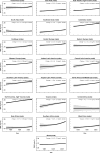National, regional, and global trends in body-mass index since 1980: systematic analysis of health examination surveys and epidemiological studies with 960 country-years and 9·1 million participants
- PMID: 21295846
- PMCID: PMC4472365
- DOI: 10.1016/S0140-6736(10)62037-5
National, regional, and global trends in body-mass index since 1980: systematic analysis of health examination surveys and epidemiological studies with 960 country-years and 9·1 million participants
Abstract
Background: Excess bodyweight is a major public health concern. However, few worldwide comparative analyses of long-term trends of body-mass index (BMI) have been done, and none have used recent national health examination surveys. We estimated worldwide trends in population mean BMI.
Methods: We estimated trends and their uncertainties of mean BMI for adults 20 years and older in 199 countries and territories. We obtained data from published and unpublished health examination surveys and epidemiological studies (960 country-years and 9·1 million participants). For each sex, we used a Bayesian hierarchical model to estimate mean BMI by age, country, and year, accounting for whether a study was nationally representative.
Findings: Between 1980 and 2008, mean BMI worldwide increased by 0·4 kg/m(2) per decade (95% uncertainty interval 0·2-0·6, posterior probability of being a true increase >0·999) for men and 0·5 kg/m(2) per decade (0·3-0·7, posterior probability >0·999) for women. National BMI change for women ranged from non-significant decreases in 19 countries to increases of more than 2·0 kg/m(2) per decade (posterior probabilities >0·99) in nine countries in Oceania. Male BMI increased in all but eight countries, by more than 2 kg/m(2) per decade in Nauru and Cook Islands (posterior probabilities >0·999). Male and female BMIs in 2008 were highest in some Oceania countries, reaching 33·9 kg/m(2) (32·8-35·0) for men and 35·0 kg/m(2) (33·6-36·3) for women in Nauru. Female BMI was lowest in Bangladesh (20·5 kg/m(2), 19·8-21·3) and male BMI in Democratic Republic of the Congo 19·9 kg/m(2) (18·2-21·5), with BMI less than 21·5 kg/m(2) for both sexes in a few countries in sub-Saharan Africa, and east, south, and southeast Asia. The USA had the highest BMI of high-income countries. In 2008, an estimated 1·46 billion adults (1·41-1·51 billion) worldwide had BMI of 25 kg/m(2) or greater, of these 205 million men (193-217 million) and 297 million women (280-315 million) were obese.
Interpretation: Globally, mean BMI has increased since 1980. The trends since 1980, and mean population BMI in 2008, varied substantially between nations. Interventions and policies that can curb or reverse the increase, and mitigate the health effects of high BMI by targeting its metabolic mediators, are needed in most countries.
Funding: Bill & Melinda Gates Foundation and WHO.
Copyright © 2011 Elsevier Ltd. All rights reserved.
Figures













Comment in
-
Stemming the global tsunami of cardiovascular disease.Lancet. 2011 Feb 12;377(9765):529-32. doi: 10.1016/S0140-6736(10)62346-X. Epub 2011 Feb 4. Lancet. 2011. PMID: 21295845 No abstract available.
-
Global trends in body-mass index.Lancet. 2011 Jun 4;377(9781):1915-6; author reply 1917-8. doi: 10.1016/S0140-6736(11)60803-9. Lancet. 2011. PMID: 21641470 No abstract available.
-
Global trends in body-mass index.Lancet. 2011 Jun 4;377(9781):1916-7; author reply 1917-8. doi: 10.1016/S0140-6736(11)60804-0. Lancet. 2011. PMID: 21641472 No abstract available.
-
Global trends in body-mass index.Lancet. 2011 Jun 4;377(9781):1917; author reply 1917-8. doi: 10.1016/S0140-6736(11)60805-2. Lancet. 2011. PMID: 21641474 No abstract available.
Comment on
-
An epidemic of risk factors for cardiovascular disease.Lancet. 2011 Feb 12;377(9765):527. doi: 10.1016/S0140-6736(11)60182-7. Lancet. 2011. PMID: 21315931 No abstract available.
References
-
- Ezzati M, Lopez AD, Rodgers A, Vander Hoorn S, Murray CJ. Selected major risk factors and global and regional burden of disease. Lancet. 2002 Nov 2;360(9343):1347–60. - PubMed
-
- Ni Mhurchu C, Rodgers A, Pan WH, Gu DF, Woodward M. Body mass index and cardiovascular disease in the Asia-Pacific Region: an overview of 33 cohorts involving 310 000 participants. Int J Epidemiol. 2004 Aug;33(4):751–8. - PubMed
-
- World Health Organization. Global health risks: Mortality and burden of disease attributable to selected major risks. Geneva: World Health Organization; 2009.
-
- Ogden CL, Fryar CD, Carroll MD, Flegal KM. Mean body weight, height, and body mass index, United States 1960–2002. Adv Data. 2004 Oct;27(347):1–17. - PubMed
Publication types
MeSH terms
Grants and funding
LinkOut - more resources
Full Text Sources
Other Literature Sources
Medical

